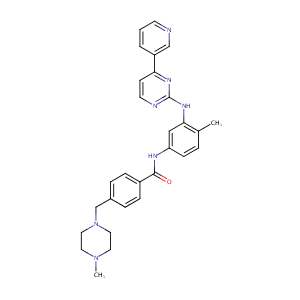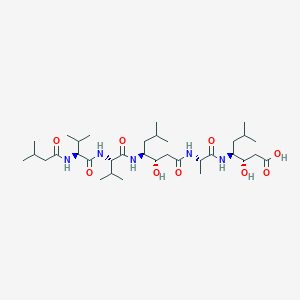| 1 |
Recurrent recessive mutation in deoxyguanosine kinase causes idiopathic noncirrhotic portal hypertension.Hepatology. 2016 Jun;63(6):1977-86. doi: 10.1002/hep.28499. Epub 2016 Mar 31.
|
| 2 |
Drugs@FDA. U.S. Food and Drug Administration. U.S. Department of Health & Human Services. 2015
|
| 3 |
Imatinib FDA Label
|
| 4 |
URL: http://www.guidetopharmacology.org Nucleic Acids Res. 2015 Oct 12. pii: gkv1037. The IUPHAR/BPS Guide to PHARMACOLOGY in 2016: towards curated quantitative interactions between 1300 protein targets and 6000 ligands. (Ligand id: 5687).
|
| 5 |
FDA Approved Drug Products from FDA Official Website. 2019. Application Number: (ANDA) 078340.
|
| 6 |
ClinicalTrials.gov (NCT04356495) Treatments to Decrease the Risk of Hospitalization or Death in Elderly Outpatients With Symptomatic SARS-CoV-2 Infection (COVID-19). U.S. National Institutes of Health.
|
| 7 |
Coronaviruses - drug discovery and therapeutic options. Nat Rev Drug Discov. 2016 May;15(5):327-47.
|
| 8 |
Design and development of antisense drugs. Expert Opin. Drug Discov. 2008 3(10):1189-1207.
|
| 9 |
Trusted, scientifically sound profiles of drug programs, clinical trials, safety reports, and company deals, written by scientists. Springer. 2015. Adis Insight (drug id 800004280)
|
| 10 |
Imatinib disturbs lysosomal function and morphology and impairs the activity of mTORC1 in human hepatocyte cell lines. Food Chem Toxicol. 2022 Apr;162:112869. doi: 10.1016/j.fct.2022.112869. Epub 2022 Feb 16.
|
| 11 |
Insulin-like growth factor I receptor pathway inhibition by ADW742, alone or in combination with imatinib, doxorubicin, or vincristine, is a novel therapeutic approach in Ewing tumor. Clin Cancer Res. 2006 Jun 1;12(11 Pt 1):3532-40. doi: 10.1158/1078-0432.CCR-05-1778.
|
| 12 |
Sensitivity to imatinib therapy may be predicted by testing Wilms tumor gene expression and colony growth after a short in vitro incubation. Cancer. 2004 Sep 1;101(5):979-88. doi: 10.1002/cncr.20457.
|
| 13 |
A comparison of physicochemical property profiles of marketed oral drugs and orally bioavailable anti-cancer protein kinase inhibitors in clinical development. Curr Top Med Chem. 2007;7(14):1408-22.
|
| 14 |
Association of genetic polymorphisms in the influx transporter SLCO1B3 and the efflux transporter ABCB1 with imatinib pharmacokinetics in patients with chronic myeloid leukemia. Ther Drug Monit. 2011 Apr;33(2):244-50.
|
| 15 |
Imatinib mesylate (STI571) is a substrate for the breast cancer resistance protein (BCRP)/ABCG2 drug pump. Blood. 2004 Nov 1;104(9):2940-2.
|
| 16 |
Contribution of OATP1B1 and OATP1B3 to the disposition of sorafenib and sorafenib-glucuronide. Clin Cancer Res. 2013 Mar 15;19(6):1458-66.
|
| 17 |
Pharmacologic markers and predictors of responses to imatinib therapy in patients with chronic myeloid leukemia. Leuk Lymphoma. 2008 Apr;49(4):639-42.
|
| 18 |
Environmental and genetic factors affecting transport of imatinib by OATP1A2. Clin Pharmacol Ther. 2011 Jun;89(6):816-20.
|
| 19 |
Potent mechanism-based inhibition of CYP3A4 by imatinib explains its liability to interact with CYP3A4 substrates. Br J Pharmacol. 2012 Apr;165(8):2787-98.
|
| 20 |
The effect of apigenin on pharmacokinetics of imatinib and its metabolite N-desmethyl imatinib in rats. Biomed Res Int. 2013;2013:789184.
|
| 21 |
Substrates, inducers, inhibitors and structure-activity relationships of human Cytochrome P450 2C9 and implications in drug development. Curr Med Chem. 2009;16(27):3480-675.
|
| 22 |
Clinical pharmacokinetics of imatinib. Clin Pharmacokinet. 2005;44(9):879-94.
|
| 23 |
Drug Interactions Flockhart Table
|
| 24 |
Role of cytochrome P450 2C8 in drug metabolism and interactions. Pharmacol Rev. 2016 Jan;68(1):168-241.
|
| 25 |
Drug-drug interactions with imatinib: an observational study. Medicine (Baltimore). 2016 Oct;95(40):e5076.
|
| 26 |
Participation of CYP2C8 and CYP3A4 in the N-demethylation of imatinib in human hepatic microsomes. Br J Pharmacol. 2010 Nov;161(5):1059-69. doi: 10.1111/j.1476-5381.2010.00946.x.
|
| 27 |
Chronic imatinib mesylate exposure leads to reduced intracellular drug accumulation by induction of the ABCG2 (BCRP) and ABCB1 (MDR1) drug transport pumps. Cancer Biol Ther. 2005 Jul;4(7):747-52.
|
| 28 |
A systems biology understanding of the synergistic effects of arsenic sulfide and Imatinib in BCR/ABL-associated leukemia. Proc Natl Acad Sci U S A. 2009 Mar 3;106(9):3378-83.
|
| 29 |
Interference with bile salt export pump function is a susceptibility factor for human liver injury in drug development. Toxicol Sci. 2010 Dec; 118(2):485-500.
|
| 30 |
Anti-leukemic effects of gallic acid on human leukemia K562 cells: downregulation of COX-2, inhibition of BCR/ABL kinase and NF-B inactivation. Toxicol In Vitro. 2012 Apr;26(3):396-405.
|
| 31 |
Effects of Imatinib Mesylate (Gleevec) on human islet NF-kappaB activation and chemokine production in vitro. PLoS One. 2011;6(9):e24831. doi: 10.1371/journal.pone.0024831. Epub 2011 Sep 14.
|
| 32 |
Chemosensitization by STI571 targeting the platelet-derived growth factor/platelet-derived growth factor receptor-signaling pathway in the tumor progression and angiogenesis of gastric carcinoma. Cancer. 2005 May 1;103(9):1800-9. doi: 10.1002/cncr.20973.
|
| 33 |
Imatinib mesylate, a new kid on the block for the treatment of anti-neutrophil cytoplasmic autoantibodies-associated vasculitis?. Clin Exp Immunol. 2008 Mar;151(3):391-8. doi: 10.1111/j.1365-2249.2007.03572.x. Epub 2008 Jan 10.
|
| 34 |
Imatinib-induced hepatotoxicity via oxidative stress and activation of NLRP3 inflammasome: an in vitro and in vivo study. Arch Toxicol. 2022 Apr;96(4):1075-1087. doi: 10.1007/s00204-022-03245-x. Epub 2022 Feb 22.
|
| 35 |
Oral lichenoid eruption secondary to imatinib (Glivec). J Dermatolog Treat. 2004 Jul;15(4):253-5. doi: 10.1080/09546630410015556.
|
| 36 |
AMP-activated protein kinase activation primes cytoplasmic translocation and autophagic degradation of the BCR-ABL protein in CML cells. Cancer Sci. 2021 Jan;112(1):194-204. doi: 10.1111/cas.14698. Epub 2020 Nov 16.
|
| 37 |
Association of CYP1A1 and CYP1B1 inhibition in in vitro assays with drug-induced liver injury. J Toxicol Sci. 2021;46(4):167-176. doi: 10.2131/jts.46.167.
|
| 38 |
Imatinib mesylate inhibits T-cell proliferation in vitro and delayed-type hypersensitivity in vivo. Blood. 2004 Aug 15;104(4):1094-9. doi: 10.1182/blood-2003-12-4266. Epub 2004 Apr 20.
|
| 39 |
Dual inhibition of RET and FGFR4 restrains medullary thyroid cancer cell growth. Clin Cancer Res. 2005 Feb 1;11(3):1336-41.
|
| 40 |
Combination of imatinib and clotrimazole enhances cell growth inhibition in T47D breast cancer cells. Chem Biol Interact. 2015 May 25;233:147-56. doi: 10.1016/j.cbi.2015.03.028. Epub 2015 Apr 8.
|
| 41 |
Efficacy of the polo-like kinase inhibitor rigosertib, alone or in combination with Abelson tyrosine kinase inhibitors, against break point cluster region-c-Abelson-positive leukemia cells. Oncotarget. 2015 Aug 21;6(24):20231-40. doi: 10.18632/oncotarget.4047.
|
| 42 |
Saikosaponin D disrupts platelet-derived growth factor- receptor/p38 pathway leading to mitochondrial apoptosis in human LO2 hepatocyte cells: a potential mechanism of hepatotoxicity. Chem Biol Interact. 2013 Oct 25;206(1):76-82. doi: 10.1016/j.cbi.2013.08.006. Epub 2013 Aug 28.
|
| 43 |
Elucidating mechanisms of toxicity using phenotypic data from primary human cell systems--a chemical biology approach for thrombosis-related side effects. Int J Mol Sci. 2015 Jan 5;16(1):1008-29. doi: 10.3390/ijms16011008.
|
| 44 |
Proapoptotic activity of bortezomib in gastrointestinal stromal tumor cells. Cancer Res. 2010 Jan 1;70(1):150-9. doi: 10.1158/0008-5472.CAN-09-1449. Epub 2009 Dec 22.
|
| 45 |
The CML-related oncoprotein BCR/ABL induces expression of histidine decarboxylase (HDC) and the synthesis of histamine in leukemic cells. Blood. 2006 Nov 15;108(10):3538-47. doi: 10.1182/blood-2005-12-028456. Epub 2006 Jul 18.
|
| 46 |
Increased expression of fibroblast growth factor receptor 3 in CD34+ BCR-ABL+ cells from patients with chronic myeloid leukemia. Leukemia. 2003 Dec;17(12):2418-25. doi: 10.1038/sj.leu.2403152.
|
| 47 |
Cytotoxicity of 34 FDA approved small-molecule kinase inhibitors in primary rat and human hepatocytes. Toxicol Lett. 2018 Jul;291:138-148. doi: 10.1016/j.toxlet.2018.04.010. Epub 2018 Apr 12.
|
| 48 |
Anthelmintic Niclosamide Disrupts the Interplay of p65 and FOXM1/-catenin and Eradicates Leukemia Stem Cells in Chronic Myelogenous Leukemia. Clin Cancer Res. 2017 Feb 1;23(3):789-803. doi: 10.1158/1078-0432.CCR-16-0226. Epub 2016 Aug 4.
|
| 49 |
In vitro studies of the combination of imatinib mesylate (Gleevec) and arsenic trioxide (Trisenox) in chronic myelogenous leukemia. Exp Hematol. 2002 Jul;30(7):729-37. doi: 10.1016/s0301-472x(02)00836-6.
|
| 50 |
Establishment and characterization of a novel imatinib-sensitive chronic myeloid leukemia cell line MYL, and an imatinib-resistant subline MYL-R showing overexpression of Lyn. Eur J Haematol. 2007 May;78(5):417-31. doi: 10.1111/j.1600-0609.2007.00835.x.
|
| 51 |
The catalytic DNA topoisomerase II inhibitor dexrazoxane (ICRF-187) induces differentiation and apoptosis in human leukemia K562 cells. Mol Pharmacol. 2001 Mar;59(3):453-61. doi: 10.1124/mol.59.3.453.
|
| 52 |
Downregulation of hERG channel expression by tyrosine kinase inhibitors nilotinib and vandetanib predominantly contributes to arrhythmogenesis. Toxicol Lett. 2022 Jul 15;365:11-23. doi: 10.1016/j.toxlet.2022.06.001. Epub 2022 Jun 6.
|
| 53 |
Investigation of imatinib and other approved drugs as starting points for antidiabetic drug discovery with FXR modulating activity. Biochem Pharmacol. 2012 Jun 15;83(12):1674-81. doi: 10.1016/j.bcp.2012.02.027. Epub 2012 Mar 7.
|
| 54 |
A new strategy for the rapid identification and validation of direct toxicity targets of psoralen-induced hepatotoxicity. Toxicol Lett. 2022 Jun 15;363:11-26. doi: 10.1016/j.toxlet.2022.05.002. Epub 2022 May 18.
|
| 55 |
Sorafenib induces apoptosis specifically in cells expressing BCR/ABL by inhibiting its kinase activity to activate the intrinsic mitochondrial pathway. Cancer Res. 2009 May 1;69(9):3927-36. doi: 10.1158/0008-5472.CAN-08-2978. Epub 2009 Apr 14.
|
| 56 |
A high-throughput screen for teratogens using human pluripotent stem cells. Toxicol Sci. 2014 Jan;137(1):76-90. doi: 10.1093/toxsci/kft239. Epub 2013 Oct 23.
|
| 57 |
Denaturing-HPLC-based assay for detection of ABL mutations in chronic myeloid leukemia patients resistant to Imatinib. Clin Chem. 2004 Jul;50(7):1205-13. doi: 10.1373/clinchem.2004.031112. Epub 2004 Apr 23.
|
| 58 |
Identification of Genes That Modulate Susceptibility to Formaldehyde and Imatinib by Functional Genomic Screening in Human Haploid KBM7 Cells. Toxicol Sci. 2016 May;151(1):10-22. doi: 10.1093/toxsci/kfw032. Epub 2016 Mar 22.
|
| 59 |
ADReCS-Target: target profiles for aiding drug safety research and application. Nucleic Acids Res. 2018 Jan 4;46(D1):D911-D917. doi: 10.1093/nar/gkx899.
|
| 60 |
Disruption of the inhibitor of apoptosis protein survivin sensitizes Bcr-abl-positive cells to STI571-induced apoptosis. Cancer Res. 2005 Sep 15;65(18):8224-32. doi: 10.1158/0008-5472.CAN-05-0303.
|
| 61 |
Epigenetic down-regulation of BIM expression is associated with reduced optimal responses to imatinib treatment in chronic myeloid leukaemia. Eur J Cancer. 2009 Jul;45(10):1877-89. doi: 10.1016/j.ejca.2009.04.005. Epub 2009 May 4.
|
| 62 |
Novel molecular targets for antimalarial drug development. Chem Biol Drug Des. 2008 Apr;71(4):287-97.
|
| 63 |
Novel molecular targets for antimalarial chemotherapy. Int J Antimicrob Agents. 2007 Jul;30(1):4-10.
|
| 64 |
Evidence of a lysosomal pathway for apoptosis induced by the synthetic retinoid CD437 in human leukemia HL-60 cells. Cell Death Differ. 2001 May;8(5):477-85. doi: 10.1038/sj.cdd.4400843.
|
|
|
|
|
|
|


